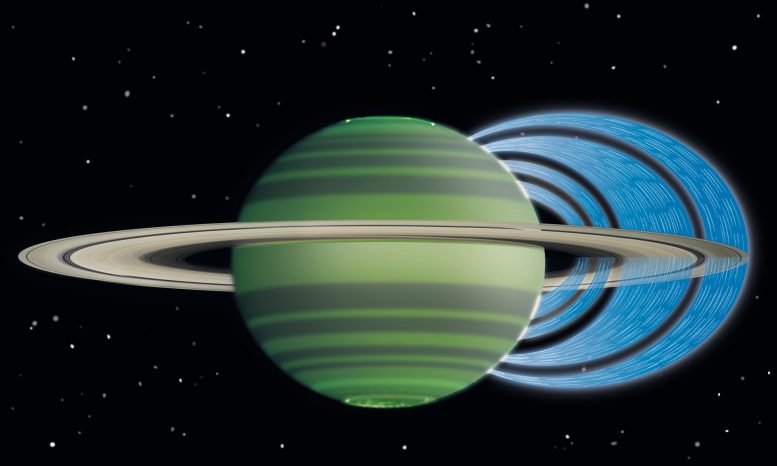
This artist’s concept illustrates how charged water particles flow into the Saturnian atmosphere from the planet’s rings, causing a reduction in atmospheric brightness. The observations were made with the W. M. Keck Observatory on Mauna Kea, Hawaii, with NASA funding. The analysis was led by the University of Leicester, England. Credit: NASA/JPL-Caltech/Space Science Institute/University of Leicester
Using the W. M. Keck Observatory, researchers reveal the effects of charged water particles on Saturn’s upper atmosphere.
NASA funded observations from the W. M. Keck Observatory with analysis led by the University of Leicester, England, tracked the “rain” of charged water particles into the atmosphere of Saturn and found the extent of the ring-rain is far greater, and falls across larger areas of the planet, than previously thought. The work reveals that the rain influences the composition and temperature structure of parts of Saturn’s upper atmosphere. The paper appears in this week’s issue of the journal Nature.
“Saturn is the first planet to show significant interaction between its atmosphere and ring system,” said James O’Donoghue, the paper’s lead author and a postgraduate researcher at Leicester. “The main effect of ring rain is that it acts to ‘quench’ the ionosphere of Saturn, severely reducing the electron densities in regions in which it falls.”
O’Donoghue said the ring’s effect on electron densities is important because it explains why, for many decades, observations have shown electron densities to be unusually low at some latitudes at Saturn.
“It turns out that a major driver of Saturn’s ionospheric environment and climate across vast reaches of the planet are ring particles located some 36,000 miles [60,000 kilometers] overhead,” said Kevin Baines, a co-author on the paper, based at NASA’s Jet Propulsion Laboratory, Pasadena, California. “The ring particles affect which species of particles are in this part of the atmospheric temperature.”
In the early 1980s, images from NASA’s Voyager spacecraft showed two to three dark bands on Saturn and scientists theorized that water could have been showering down into those bands from the rings. Those bands were not seen again until 2011 when the team observed the planet with Keck Observatory’s NIRSPEC, a unique, near-infrared spectrograph that combines broad wavelength coverage with high spectral resolution, allowing the observers to clearly see subtle emissions from the bright parts of Saturn.
The ring rain’s effect occurs in Saturn’s ionosphere (Earth has a similar ionosphere), where charged particles are produced when the otherwise neutral atmosphere is exposed to a flow of energetic particles or solar radiation. When the scientists tracked the pattern of emissions of a particular hydrogen molecule consisting of three hydrogen atoms (rather than the usual two), they expected to see a uniform planet-wide infrared glow. What they observed instead was a series of light and dark bands with a pattern mimicking the planet’s rings. Saturn’s magnetic field “maps” the water-rich rings and the water-free gaps between rings onto the planet’s atmosphere.
They surmised that charged water particles from the planet’s rings were being drawn towards the planet by Saturn’s magnetic field and neutralizing the glowing triatomic hydrogen ions. This leaves large “shadows” in what would otherwise be a planet-wide infrared glow. These shadows cover 30 to 43 percent of the planet’s upper atmosphere surface from around 25 to 55 degrees latitude. This is a significantly larger area than suggested by the Voyager images.
Both Earth and Jupiter have a very uniformly glowing equatorial region. Scientists expected this pattern at Saturn, too, but they instead saw dramatic differences at different latitudes.
“Where Jupiter is glowing evenly across its equatorial regions, Saturn has dark bands where the water is falling in, darkening the ionosphere,” said Tom Stallard, one of the paper’s co-authors at Leicester. “We’re now also trying to investigate these features with an instrument on NASA’s Cassini spacecraft. If we’re successful, Cassini may allow us to view in more detail the way that water is removing ionized particles, such as any changes in the altitude or effects that come with the time of day.”
Reference: “The domination of Saturn’s low-latitude ionosphere by ring ‘rain’” by J. O’Donoghue, T. S. Stallard, H. Melin, G. H. Jones, S. W. H. Cowley, S. Miller, K. H. Baines and J. S. D. Blake, 10 April 2013, Nature.
DOI: 10.1038/nature12049
Keck Observatory observing time for this investigation was funded by NASA. The Cassini-Huygens mission is a cooperative project of NASA, the European Space Agency, and the Italian Space Agency. The mission is managed by JPL for NASA’s Science Mission Directorate, Washington.
The W. M. Keck Observatory operates the largest, most scientifically productive telescopes on Earth. The two, 10-meter optical/infrared telescopes on the summit of Mauna Kea on the Island of Hawaii feature a suite of advanced instruments including imagers, multi-object spectrographs, high-resolution spectrographs, integral-field spectroscopy and a world-leading laser guide star adaptive optics system. The Observatory is a private 501(c) 3 non-profit organization and a scientific partnership of the California Institute of Technology, the University of California, and NASA.


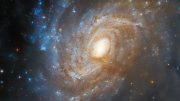


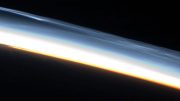
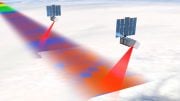
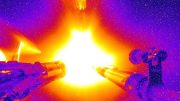
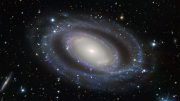
I’m not a scientist, but I’m absolutely blown away by the theories and discoveries that are being revealed thru technology and good old fashioned brain power. I will certainly have to re-read this article – it’s no good trying to skim it. To think of “rain” on Saturn has certainly diverted me from my fascination with Mars.
Someone tell me how rain is going to be found that far from the sun, that far from a planet? I would think maybe snow, or some kind of crystal, but not any liquid.
These findings, pictures and illustrations serve to reinforce to me that the electrical equitorial current as with the Auroral or “Birkeland” currents are created by a simple thing called magnetic reconnection.
Bodies such as planets are rotating magnets and the photons from the sun cut through the main streams of attracted electrons following the magnetic lines of force into the poles. This concentrated magnetic re-connection point is of course the auroral rings display, and the shimmering lights are the reflections of photons striking the electrons at a perpendicular angle. This in turn causes huge amounts of electrical energy to be created, thus birkeland and more importantly and less known equatorial high voltage regions. These voltages are “shelled by the magnetic influences perpendicular..I imagine if you looked at the planet edge on, the ring would appear more as the dark line in a band gap of spectrum.. the high frequency spike is the resonant frequency of the energy generated..ultra high on Saturn.. what do you think??
The electrostatic induction caused by magnetic re-connection, which is caused by energetic photons intersecting the magnetic lines of force at the poles, perpendicularly. This is demonstrated in the aurora’s.. The reason we see colors and sheets that “shimmer” is result of the revolving magnetic field. The rings on Saturn are arranged by these magnetic field lines intersecting with a huge induced voltage. This could be proven with a like test of a rotating magnetic field in space! High speed rotation.